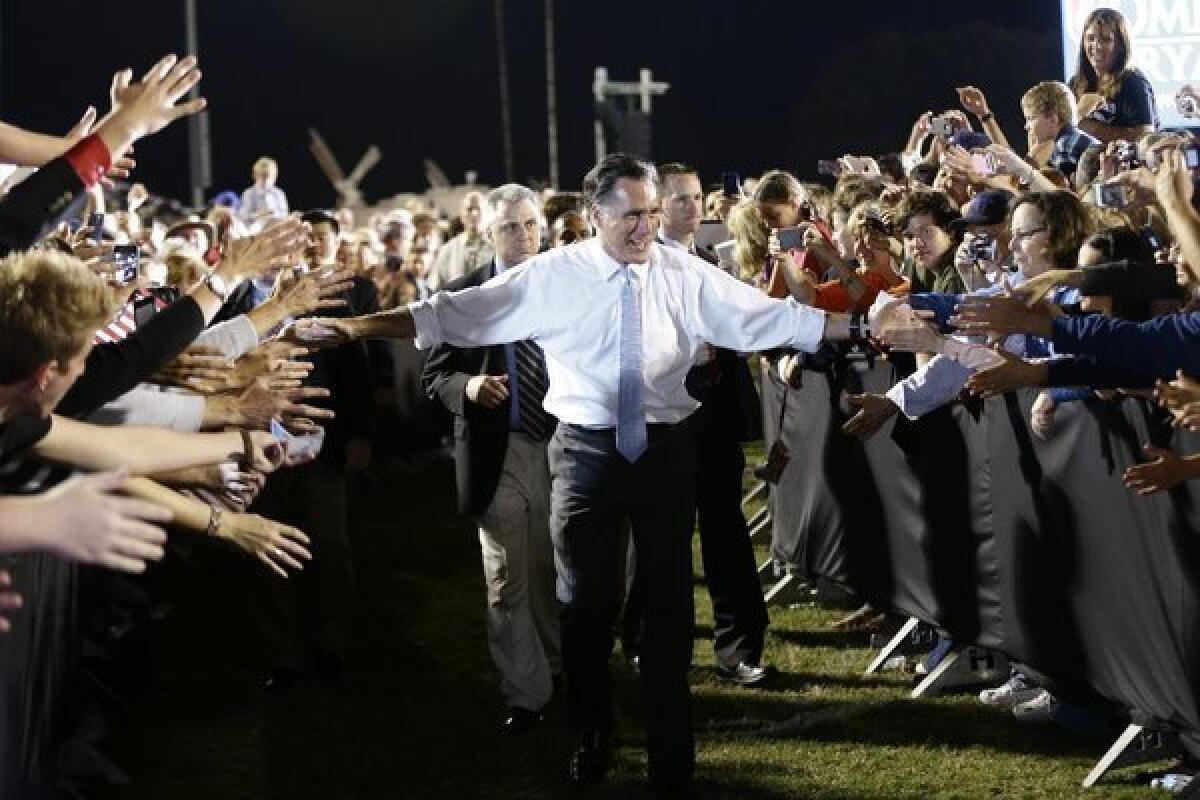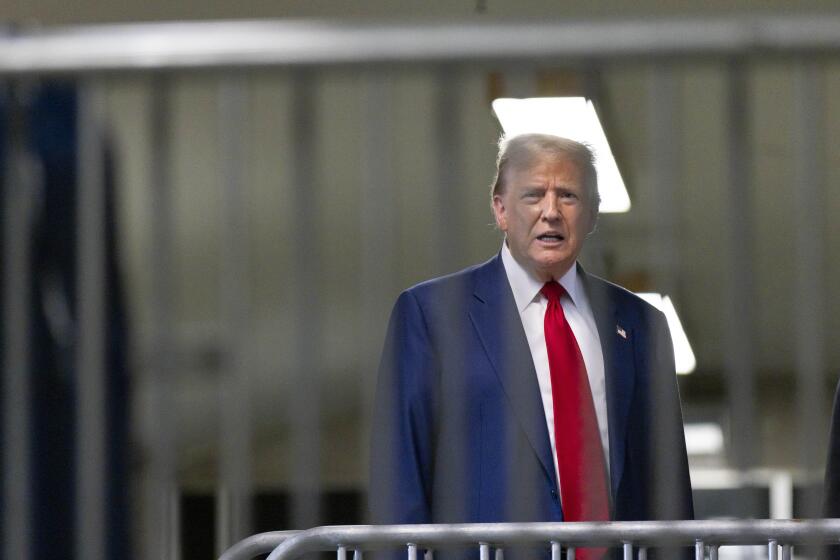Romney savors the moment, but tough electoral math still looms

DEFIANCE, Ohio — The crowd had been pumped up for hours when Mitt Romney finally took the stage Thursday night at the 50-yard-line of the football field under hot lights in this tiny town. They had filled the bleachers and stomped their feet to the fiddle-and-guitar stylings of Alabama’s Randy Owen’s during “Dixieland Delight,” and now they surrounded Romney on all sides — cheering with gusto.
Romney, who for so long was the safe but unloved choice within his party, stood for a moment taking it in, patting his hand on his heart to express his gratitude for this new level of fervor. His aides cranked the volume of his campaign anthem, Kid Rock’s “Born Free,” to sustain the applause.
“I have to tell you,” the former Massachusetts governor said. “I don’t recall having so much fun in such a long time.”
It has been three weeks since Romney’s turning point in the first debate, when his commanding performance reversed a growing sense of doom around his campaign and brought him back into close contention with President Obama.
Even his advisers acknowledge that he still faces a steep climb. Obama appears to be in a far stronger position in the race to 270 electoral votes with a rough tally of 243, based on states that are solidly in or leaning toward his column. If he can pull out a win in North Carolina, Romney could potentially count on 206 electoral votes and would most likely need to win at least two out of three in Florida, Ohio and Virginia, along with several other states, to vanquish the president.
But in the midst of roaring crowds, lavishly produced events that begin with crooning country stars and end with bursts of fireworks, it is easy for Romney fans to forget the difficulty of that math. Though his crowds will never approach the size of President Obama’s, they have surged into the thousands, believing that he might actually pull this thing off.
At a campaign event near her home of Centerville, Ohio, Diane Ritter said she had been nervously watching for omens: the ratio of Romney to Obama yard signs in her neighborhood (split between the two parties in 2008, but now “all Romney”); the poll of the eighth-graders at her son’s school (last election it was a tie, this year Romney won); and the level of frustration among her friends, who like her, cannot find “good work” despite being $40,000 in debt for a master’s degree “for nothing.”
“But I still think it’s an even race; I think it’s close, which honestly I don’t understand,” said Ritter, who has at times watched the campaign in frustration.
She faults Romney for not doing a better job explaining his secretly taped remark about the 47% of Americans he said were dependent on government. She cannot understand why he is not hitting the Obama administration harder on Libya, which has all but vanished from his stump speech. But most of all, Ritter wants Romney to get more aggressive.
INTERACTIVE: Battleground states map
“He has got to come out stronger,” she said repeatedly as she waited for Romney to take the stage in Cincinnati last week.
For his part, Romney has finally picked up his pace, returning to the 15-hour days that were a hallmark of his primary campaign. To avoid mistakes, message control is tighter than ever — no interviews, not even local ones. When reporters ask whether he’ll come back to talk on the plane as he shuttles among the seven most important states — Colorado, Florida, Iowa, New Hampshire, Ohio, Virginia and Wisconsin — the answer is always no.
Romney’s stump speech is largely unchanged from the summer: a critique of what he views as the president’s failures to recharge the economy, an explanation about his five-point plan to create 12 million jobs, a lengthy pledge about his plans to expand the U.S. military, and a series of stories about the people he’s met who he says have restored his faith in America.
But there is less red meat for his own party as he seeks to close his deficit with Obama among independents and women in key swing states.
Instead, he is placing an extra emphasis now on his record of bipartisanship in Massachusetts — which Democrats dispute — and on his plans to transform the education system by moving toward greater school choice.
INTERACTIVE: Spending during the 2012 election
“If you’ve got kids in school, this election is a big election for you,” he said last week at a steel processing plant in Worthington, Ohio. “I want to make sure that your kids have the choice that you’d like them to have, and make sure the federal dollars follows the child to the school of your choice.”
Romney often now speaks at length about the need for greater bipartisanship in Washington, an implicit reference to the healthcare plan that he pushed through in Massachusetts with the help of Democrats.
In Pensacola, Fla., on Saturday, he said Obama had “shrunk from the promises he made as a candidate.”
“He promised that his would be a post-partisan presidency, but we’ve watched him over these last four years and he’s been divisive, and demonized almost any group that opposed him,” Romney said. “We have to build bridges to people in the other party. We have to recognize this is not a time in America for us to pull back, and to divide and to demonize. It’s a time in America for us to come together, to look for common ground, for places where we have agreement.”
But perhaps what Romney’s supporters like most these days is his confidence. “If I’m president — WHEN I’m president,” he often says at his events these days. It’s a bit of campaign theatrics, but without fail, his crowds roar with approval.
Follow Politics Now on Twitter and Facebook
Twitter: @maevereston
Times staff writer Seema Mehta contributed to this report.
More to Read
Get the L.A. Times Politics newsletter
Deeply reported insights into legislation, politics and policy from Sacramento, Washington and beyond. In your inbox three times per week.
You may occasionally receive promotional content from the Los Angeles Times.







